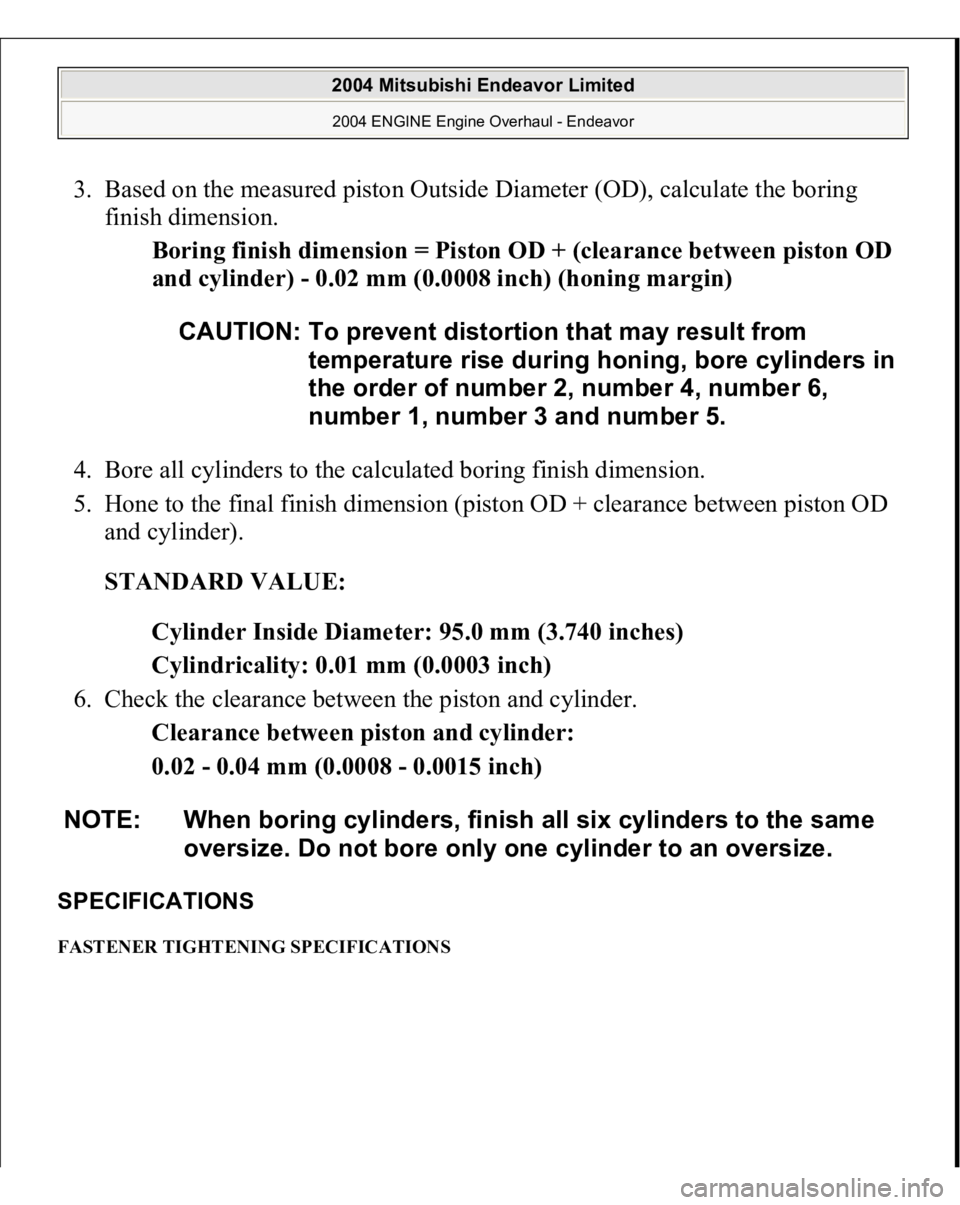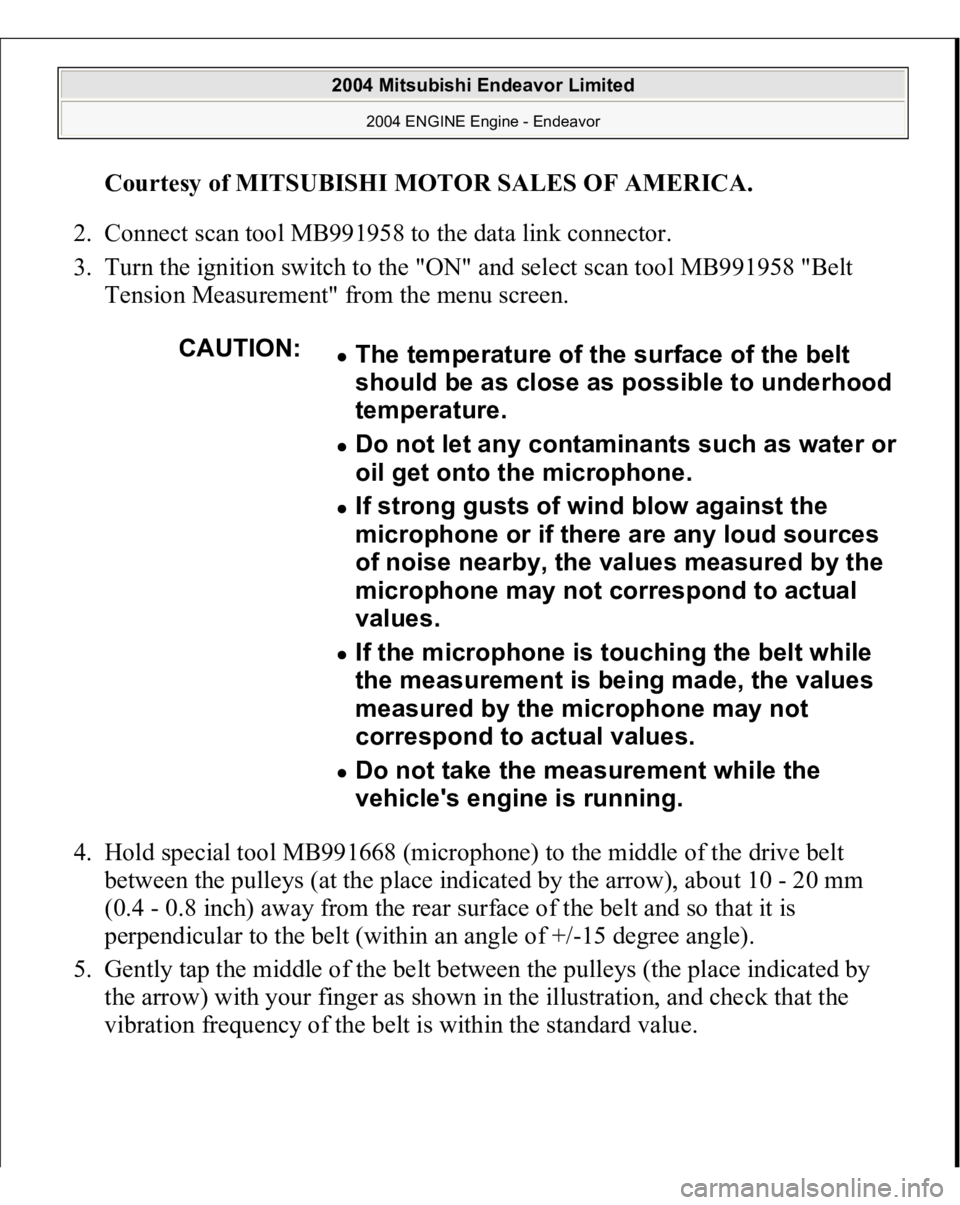Page 1481 of 3870
0.03 - 0.04 mm (0.0012 - 0.0016 inch) < No.2, 3 >
Limit: 0.1 mm (0.003 inch)
Fig. 152: Measuring Width Of Smashed Plastic Gauge
Courtesy of MITSUBISHI MOTOR SALES OF AMERICA.
CRANKSHAFT REAR OIL SEAL 1. Check the oil seal lip for wear and damage.
2. Check the rubber for deterioration or hardening.
3. Check the oil seal case for cracks and damage. CYLINDER BLOCK 1. Visually check for scratches, rust, and corrosion. Use a flaw detecting agent for
2004 Mitsubishi Endeavor Limited 2004 ENGINE Engine Overhaul - Endeavor
Page 1482 of 3870
the check. If defects are evident, correct or replace.
2. Using a straightedge and feeler gauge, check the block top surface for warpage.
Make sure that the surface is free from gasket chips and other foreign matter.
Standard value: 0.05 mm (0.002 inch)
Limit: 0.1 mm (0.003 inch)
3. If the distortion is excessive, correct within the allowable limit or replace.
Grinding limit: *0.2 mm (0.008 inch)
*Includes/combined with cylinder head grinding.
Cylinder block height (when new):
227.9 - 228.1 mm (8.972 - 8.980 inches)
Fig. 153: Checking Cylinder Block
Courtesy of MITSUBISHI MOTOR SALES OF AMERICA.
2004 Mitsubishi Endeavor Limited 2004 ENGINE Engine Overhaul - Endeavor
Page 1483 of 3870
4. Check the cylinder walls for scratches and seizure. If defects are evident,
correct (bored to an oversize) or replace.
5. Using a cylinder gauge, measure the cylinder bore and cylindricality. If worn
badly, correct by boring the cylinders to an oversize and replace pistons and
piston rings. Measure at the points shown in the illustration.
STANDARD VALUE:
Cylinder Inside Diameter: 95.0 mm (3.740 inches)
Cylindricality: 0.01 mm (0.0003 inch)
Fig. 154: Measuring Cylinder Bore
Courtesy of MITSUBISHI MOTOR SALES OF AMERICA.
BORING CYLINDER
2004 Mitsubishi Endeavor Limited 2004 ENGINE Engine Overhaul - Endeavor
Page 1485 of 3870

3. Based on the measured piston Outside Diameter (OD), calculate the boring
finish dimension.
Boring finish dimension = Piston OD + (clearance between piston OD
and cylinder) - 0.02 mm (0.0008 inch) (honing margin)
4. Bore all cylinders to the calculated boring finish dimension.
5. Hone to the final finish dimension (piston OD + clearance between piston OD
and cylinder).
STANDARD VALUE:
Cylinder Inside Diameter: 95.0 mm (3.740 inches)
Cylindricality: 0.01 mm (0.0003 inch)
6. Check the clearance between the piston and cylinder.
Clearance between piston and cylinder:
0.02 - 0.04 mm (0.0008 - 0.0015 inch) SPECIFICATIONS FASTENER TIGHTENING SPECIFICATIONS
CAUTION: To prevent distortion that may result from
temperature rise during honing, bore cylinders in
the order of number 2, number 4, number 6,
number 1, number 3 and number 5.
NOTE: When boring cylinders, finish all six cylinders to the same
oversize. Do not bore only one cylinder to an oversize.
2004 Mitsubishi Endeavor Limited 2004 ENGINE Engine Overhaul - Endeavor
Page 1498 of 3870
Fig. 6: Special Tool Chart (4 Of 4)
Courtesy of MITSUBISHI MOTOR SALES OF AMERICA.
ON-VEHICLE SERVICE 7. DRIVE BELTS (FOR GENERATOR, POWER STEERING OIL PUMP AND AIR CONDITIONING)
(CHECK) GENERATOR DRIVE BELT TENSION CHECK < WHEN USING SCAN TOOL MB991958 > Required Special Tools:
MB991958: Scan Tool (MUT-III Sub Assembly) [MB991824: Vehicle
Communication Interface (V.C.I.)] MB991668: Belt Tension Meter Set
CAUTION: To prevent damage to scan tool MB991958, always
2004 Mitsubishi Endeavor Limited
2004 ENGINE Engine - Endeavor
Page 1501 of 3870

Courtesy of MITSUBISHI MOTOR SALES OF AMERICA
.
2. Connect scan tool MB991958 to the data link connector.
3. Turn the ignition switch to the "ON" and select scan tool MB991958 "Belt
Tension Measurement" from the menu screen.
4. Hold special tool MB991668 (microphone) to the middle of the drive belt
between the pulleys (at the place indicated by the arrow), about 10 - 20 mm
(0.4 - 0.8 inch) away from the rear surface of the belt and so that it is
perpendicular to the belt (within an angle of +/-15 degree angle).
5. Gently tap the middle of the belt between the pulleys (the place indicated by
the arrow) with your finger as shown in the illustration, and check that the
vibration fre
quenc
y of the belt is within the stan
dard value.
CAUTION:
The temperature of the surface of the belt
should be as close as possible to underhood
temperature. Do not let an
y contaminants such as water or
oil get onto the microphone.
If strong gusts of wind blow against the
microphone or if there are any loud sources
of noise nearby, the values measured by the
microphone may not correspond to actual
values. If the microphone is touching the belt while
the measurement is being made, the values
measured by the microphone may not
correspond to actual values. Do not take the measurement while the
vehicle's engine is running.
2004 Mitsubishi Endeavor Limited
2004 ENGINE Engine - Endeavor
Page 1502 of 3870
Fig. 8: Checking Vibration Frequency Of Belt Is Within Standard Value
Courtesy of MITSUBISHI MOTOR SALES OF AMERICA.
Standard value:
STANDARD VALUE
Part No.
Vibration frequency Hz
MD368275
133 - 158
2004 Mitsubishi Endeavor Limited
2004 ENGINE Engine - Endeavor
Page 1503 of 3870
< WHEN USING THE TENSION GAUGE > Use a belt tension gauge to check that the belt tension is within the standard value.
Standard value: 490 - 686 N (110 - 154 lb)MN158101, MN187016
143 - 169
NOTE: Because the frequency depends on the belt material,
confirm Part No. shown on the reverse of the belt.
2004 Mitsubishi Endeavor Limited
2004 ENGINE Engine - Endeavor